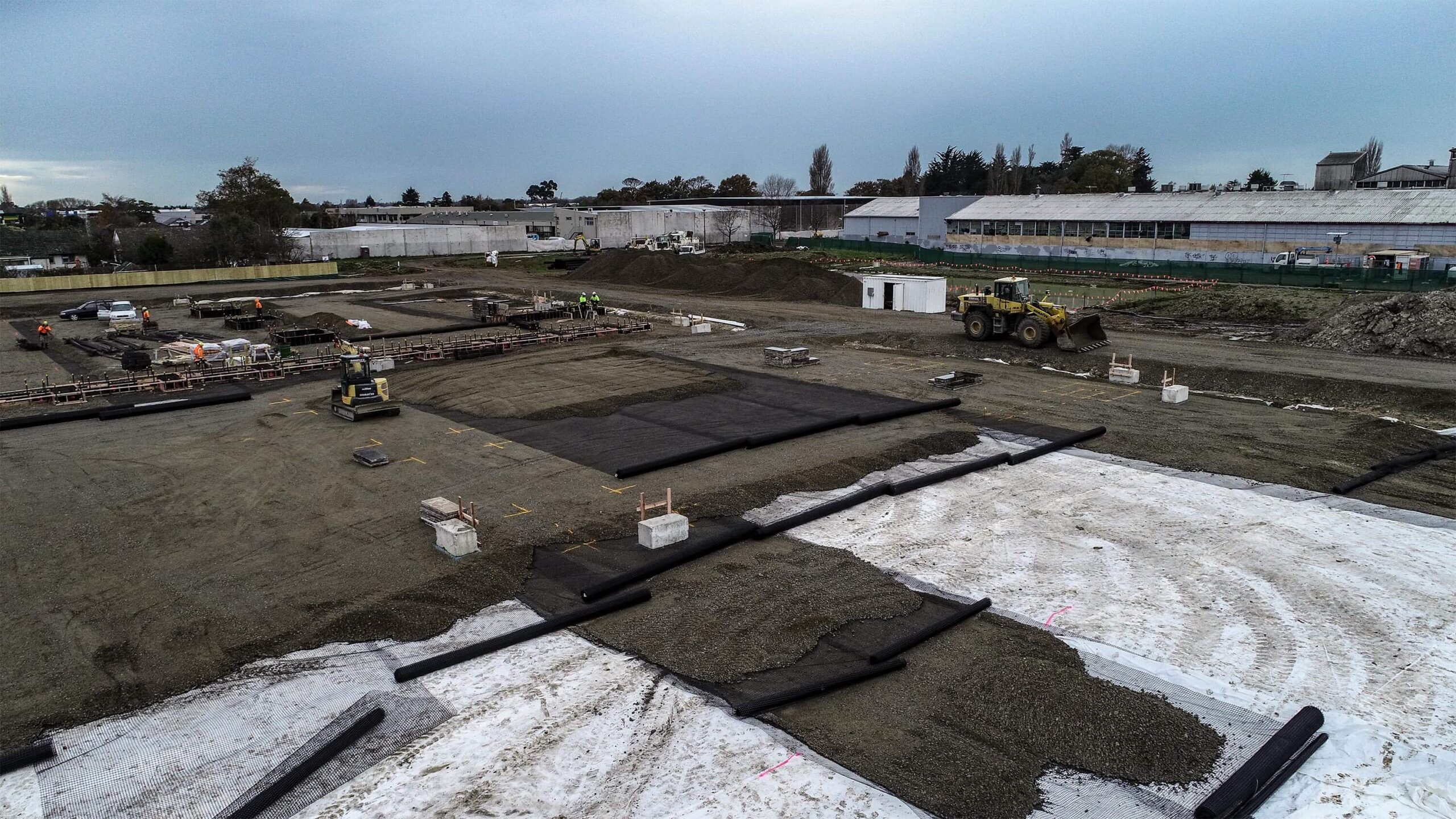What are Geogrids used for?
As already mentioned, geogrids are most commonly used in construction, landscaping, and hardscaping projects for a variety of applications. These tend to fall into one of two categories; ground stabilisation and reinforcement or slope stabilisation and reinforcement. Let’s take a look at each one in a bit more depth.
Using Geogrid for ground stabilisation
In ground stabilisation projects, geogrids are typically deployed for three reasons:
To provide a firm working surface - Building on soft subgrade soils can have serious load-bearing consequences if not properly reinforced. Installing geogrid in these conditions can improve the strength of soft subgrade soils, giving you a solid base for your construction.
To enhance service life - Pavements built on highly expansive subgrade soils can be subject to environmental cracking, which reduces their service life. Installing geogrid under a pavement can help to stabilise the subgrade and reduce its susceptibility to this problem.
To reduce the structural cross-section - Traditionally, roadways need to be built on thick bases to increase their stiffness and stability against the loads they will be subjected to. Doing so, however, can be both costly and time-consuming. Reinforcing the soil with geogrid can reduce the thickness of the base required to achieve the same level of stability, thus reducing time and material costs while also increasing the service life of the construction.
Geogrids can be used in this way to stabilise and reinforce patios, walkways, driveways, and roads.
Using Geogrid for slope reinforcement
In slope reinforcement projects, geogrids are typically deployed to increase the structural integrity of soil backfills and prevent sliding on steep embankments. One of the most common applications for geogrid slope reinforcement is in the construction of retaining walls. Using geogrids to hold together and reinforce the soil backfill helps to prevent any ground movement behind, and the subsequent force that would be applied to, a retaining wall. As well as confining the backfill soil, which is especially useful in areas with soft soil, installing geogrids helps to distribute the load and enables retaining walls and landfills etc., to be built higher and steeper more safely.
Using geogrids in slope reinforcement projects can help to make them:
More economical - Traditionally, the higher a retaining wall needed to be, the thicker it would have to be to hold back the soil behind it. Extra thickness means extra materials and extra cost, all of which can be reduced by reinforcing the soil with geogrids.
More environmental - Geogrids can help to minimise the environmental impact of embankment and earth wall constructions, allowing you to reuse poor quality in-situ fill material that can help to encourage the slopes back to their natural vegetated state.
More flexible - Retaining walls built with geogrid systems in place are also better equipped to adapt to deformations in the foundations of the construction. This means they are more resistant to the effects of earthquakes*.
*Fun Fact: Typically, 200 to 300 earthquakes are detected in the UK by the British Geological Survey each year. While most of them can’t be felt, the vibrations they send through the ground can be strong enough to shake the soil a bit. Over time and hundreds of repeated shakings, these small tremors can cause enough movement in the soil to weaken its load-bearing capabilities. However small a problem this might be in the UK, having Geogrid in place can still protect your structures from it.
Can Geogrid be used as a grass support system?
Have you ever been at a public event with an overspill car park on a grassy area and seen some sort of reinforcement grid or mesh laid down to stop the ground from getting churned up? Well, that probably wasn’t geogrid. While it does look like they could do the same job, geogrids simply aren’t designed for use above ground, where they can be subjected to the direct force and weight of vehicles.
In terms of overspill car parks, pedestrian grassed areas, golf course buggy routes etc., there are other potential alternatives you should look for instead. If you are more interested in this sort of solution than geogrid, call or email us today to see how we can help.

How do you install a Geogrid?
Installing geogrid is relatively simple. The key is in ensuring that the desired reinforcement or stabilisation properties are achieved through the correct interplay between the subgrade, the geogrid, and any aggregate that may be required. The difficulty in writing an installation guide is that every project will be different and require site-specific considerations to be taken into account. For that reason, this will just be a very brief overview of the basics.
Installing geogrids for use in retaining walls
Uniaxial geogrids need to be rolled out perpendicular to the wall in lengths that should be dictated by a certified engineer’s recommendations based on the height of the wall, the conditions of the soil and subgrade, and the potential load the wall will have to support. The direction at which the geogrid is laid in relation to the wall is the most important thing to get right, however. If it is laid parallel to the wall, or you fail in any other way to follow the exact instructions given by the manufacturer, a uniaxial Geogrid will not provide the strength and stability needed to make the retaining wall safe.
Installing geogrids for use in ground stabilisation
Biaxial geogrids should be rolled out and allowed to follow the natural contours of the soil. The direction, depth, and whether or not multiple layers are required are all decisions that should be made off the back of a qualified engineer’s recommendations. In most cases, the geogrid can be laid either parallel to the road or pavement centreline or at right angles to it. Using a biaxial geogrid, which has the required tensile strength in both directions, means the direction is less important than it is for uniaxial geogrids. If multiple layers of geogrid are recommended throughout the depth of the fill, they should be evenly spaced with, typically, no more than 500mm between them. Always check the manufacturer’s instructions to be certain, though.
Once in place, each length of geogrid should be hand-tensioned (pulled tight) to make sure the joints are taught, and there is no slack in the grid. It is often a good idea to hold the geogrid in place at this point with small deposits of fill to avoid losing that tension. Depending on the type of soil the geogrid is being laid upon, various amounts of overlap between the lengths will be required. If this is not done correctly, it can weaken the unified strength of the geogrid installation. Again, it is essential that you follow the manufacturer’s instructions on this and any guidance offered by the engineer. The same then goes for the final steps, which involve placing the cover fill and compacting it down.
Do Geogrids need maintenance?
Given that geogrids are typically installed underneath pavements and roads, behind retaining walls, etc., maintaining them would be a little tricky. For this reason, most geogrids on the market are designed to have a long lifespan, usually between 40 and 100 years, depending on the application. Once installed, it’s virtually impossible to maintain a geogrid without digging it up. It is vitally important, therefore, to ensure that you get the right type of geogrid for your project and install it correctly to get the most benefit.


